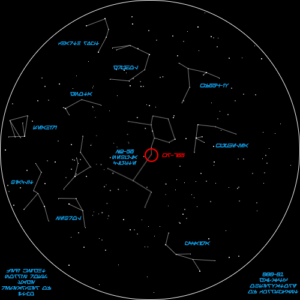385.12 // Astronomers baffled by vanished star in a distant galaxy
On 384.12, astronomers of the Chandrila Larger Array Telescope reported a discrepancy between their bi-year astro-cartographical assessment and the observations from their telescope. Following this report, 37 major astronomical observatories have confirmed the discrepancy, causing excitement among the astronomical community.
All this excitement revolves around WR-765 star, in the Nebula N2-56, around 2 billions light years away. WR-765 is (or should we say, was) a Classic or Population 1 star, that according to Astronomy sources has lost its layer of Hydrogen, and was now fusing Helium. Put simply, it was in the second stage of its stellar life and had about two hundred to six hundred millions of years, before we expected it to explode violently into an impressive Supernova, leaving a black Hole five times larger that a standard Sun.
But, contrary to all our expectations, the star went off far sooner, and not with a bang, but a whimper. According to the now aggregated astronomical data, we stopped receiving light from the star between 382.27 and 383.02. Even more remarkably, it appears that regardless of distance, arc of observation or relative planetary speeds, all observations appear to be astronomically simultaneous, at least in the orders of magnitude Astronomy is concerned. To put simply, such a disappearance should have been observed in very different time periods for each observatory, as expected by our current understanding of the universe.
“This is amazing, it’s the first discovery that does not fit with our astronomical models in thousand of years! There is no precedence like this in the galaxy, nor any similar event registered. A new day for Astronomy, a new day for all Physics has dawned”, said Dr. Maani Inkari, Associate Proffessor of Stellar Progression Mechanics.
When asked if this event is a cause for concern, Proffessor Bama Kallos of Corruscant was reassuring:
“This event has already taken place in that galaxy at least two billion years ago, had there been any worrisome events we would have long noticed by now. While it is currently unexplainable, we would do well to remember that this is how science evolved, discovering unexplainable events, and working them out. It’s a very interesting discovery, and I can’t wait to see where it will lead us.”
But not all scientists are so excited. Others are pointing out to more mundane explanations, to explain this event, such as Professor Pamaf Burkan, of the Institute of Stellar Physics:
“Caution should always be advised when the public is treated to sensuous and mysterious headlines. It’s not a miracle event, untill all other cases have been exhaustively tested. With careful observation, we might find a large gas cloud obscuring observation, or a larger planetary body covering our arc or even a larger, unobserved black hole, in transit between Galaxies.”
Whatever the reason for this mysterious disappearance is, the spark of excitement that it ignited within the community is impossible to miss.
Sovi Ya’qul for the Republic Daily

